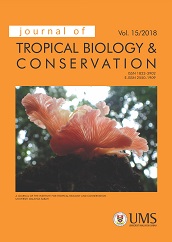Assemblage Structure of Palaeotropical Frugivorous Bats at Mineral Licks Sites in Deramakot and Tangkulap Forest Reserve, Sabah
DOI:
https://doi.org/10.51200/jtbc.v15i.1483Keywords:
Palaeotropical frugivorous bats, mineral licks, Deramakot and Tangkulap Forest Reserve, SabahAbstract
Few studies have been done on natural mineral licks visitation on bat fauna, particularly in Borneo and Southeast Asia in general. Little is known about the assemblage of bats using mineral licks and this study was done to determine assemblage structure of Palaeotropical bats at six established mineral licks in Deramakot and Tangkulap Forest Reserve, Sabah. The main findings of the present study revealed that Palaeotropical frugivorous bats were using mineral licks, observed through their behaviour of drinking from mineral licks, supported by their high species occurrences at mineral licks and higher concentration of water insoluble soil tracer elements, Al and Si detected in their faeces in comparison with non-visitor bats. The five species of bats Macroglos susminimus (n=3), Balionycteris maculata (n=2), Cynopterus brachyotis (n=1), Megaerops ecaudatus (n=2) and Penthetor lucasii n=(1) were observed drinking from mineral licks. Four species of frugivorous bats (M. minimus, B. maculata, C. brachyotis and P. lucasii) frequently occurred at all six sites at mineral licks. In addition, there were higher enrichment Al and Si in M. minimus faeces (n=5) in comparison with non-visitor bats suggesting that frugivorous bats got those elements from ingestion of mineral lick muddy water.
Downloads
Published
How to Cite
Issue
Section
License
BY: credit must be given to the creator.
NC: Only noncommercial uses of the work are permitted.
This journal provides open access to its content under CC BY-NC 4.0 on the principle that making research freely available to the public supports greater international collaboration and information exchange.












